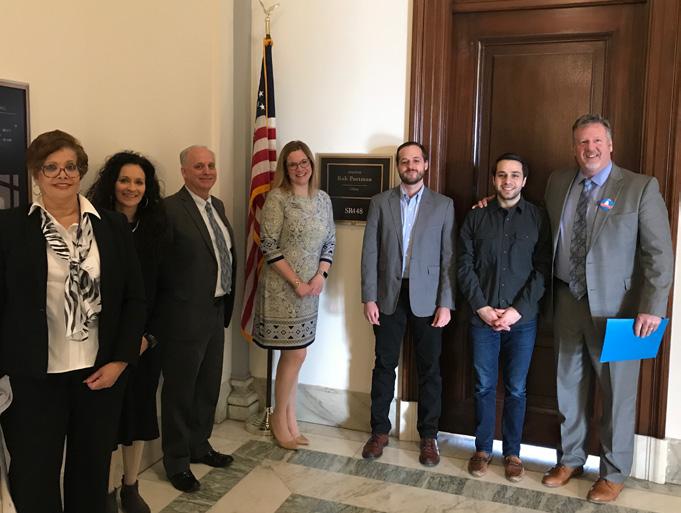
4 minute read
From the Desk of our Associate Executive Director
FROM THE DESK OF OAESA’S Associate Executive Director
Shining a New Light:
Advertisement
PDK POLL ILLUMINATES POSITIVE CHANGE IN PUBLIC PERCEPTIONS OF EDUCATION
BY MARK JONES
Imight be going out on a limb here, but I’m guessing some of you have, at one time or another, felt underappreciated by the community you serve. Or perhaps misunderstood, or even disrespected. We are regularly bombarded by stories in the media that decry all that is wrong with our nation’s education system, and it can often seem like the general public has lost confidence in our work. It’s enough to make even the most ardent educator question their purpose and to wonder where all the “magic” went! Before you simply take this negative portrayal at face value, I’d encourage each of you to look a little deeper for evidence of how the American public truly perceives the performance of its schools. Recently, I attended an NAESP conference that featured a session by Joshua Starr, CEO for Phi Delta Kappa (PDK) International. Mr. Starr’s presentation shed a bright light on the results of the recently completed PDK Poll of the Public’s Attitudes Toward the Public Schools. PDK has conducted this poll every year for the past five decades, so their findings are not only longitudinal, valid, and reliable—they’re fascinating, too! For example, want to know what the general public feels about teacher pay, especially in light of recent statewide teacher strikes around the country over poor compensation? You might be pleased to know that, according to the PDK Poll, two thirds (66%) of Americans believe that teacher salaries in their community are too low. Even more surprising, given the anti-school rhetoric we often hear, is the fact that nearly three-fourths (73%) of respondents said they would support the teachers in their community if they went out on strike for higher pay! Now, I’m certainly not advocating that as a labor tactic, but I will view this attitude as a sign of the public’s recognition of, and appreciation for, the hard work our educators perform each day in their classrooms. Want further proof of the public’s support of our work? When asked if they feel the best approach to improving public education is to simply reform the existing system or to find a new alternative, a whopping 78% indicated a desire to work on making our current public schools better. Or, when asked to share what they feel is the biggest problem facing public schools today, for the seventeenth year in a row, the public’s clear winner was “lack of financial support.” (Prior to the 2000 poll, lack of funding had only topped the list of problems twice in the previous 30 years! So, it appears that our country does, indeed, understand the value in providing quality public schooling for our children, and also the recognition that we haven’t done what is necessary to fund it. Finally, are you curious about how the public would grade our schools, if asked to use an A-F scale? Well, as you might guess, that depends on which schools they are asked to evaluate. When grading their own child’s school, 70% would score it as an A or B, and this percentage has remained fairly consistent over the past thirty years. When rating the other schools in their community, the percentage giving those schools an A or B dips to 43%. And, when considering public schools across the nation, here public confidence drops off substantially, as only 19% score these in the A-B range. This year’s poll asks the public many other illuminating questions, including some dealing with school safety and whether or not they would want their own children to become a teacher. The results can be found online at PDKpoll.org and downloaded. Like me, I think you’ll be intrigued by the results, and I encourage you to spend a little time going over them. In fact, you might find them worth sharing in a staff meeting, or with your community. After all, a little enlightenment can be a good thing! “It appears that our country does, indeed, understand the value in providing quality public schooling for our children.”
7%
31 %
Improvement in State Science Test Scores University of North Florida Dr. Matt Ohlson
Decrease in Discipline Referrals Benedictine University Dr. Chantel Ishola
34 %
96 %
Increase in Positive SocialEmotional Behaviors St. John’s University Dr. Loreta Andersen
Positive Impact in Developing Leadership Skills Samford University Dr. Cherie Humphries
Objective evidence of Leader in Me effectiveness has been steadily growing since 2010. To date, over 30 independent, academic-research studies have evaluated—and validated—positive impacts of Leader in Me across a wide variety of areas. Below are research highlights from each of these areas, organized by the related Leader in Me outcome within three broad categories: Leadership, Culture, and Academics.
Arizona State University (1) California State University (1) Capella University (2) College of Saint Rose (1) Dordt College (1) Eötvös Loránd University (1) Gardner-Webb University (1) Johns Hopkins University (2) Lamar University (1) Missouri Baptist University (1) Northwest Missouri State University (1) St. John’s University (1) Texas A&M University (1) University of Alberta (2) University of Louisiana at Lafayette (2) University of Michigan (2) University of Missouri (1) University of North Florida (2) University of Northern Iowa (2) University of Pécs (1) University of Southern Mississippi (1) Virginia Commonwealth University (1) Walden University (1) Wingate University (1) The academic studies were conducted by the following colleges and universities: Leader in Me is endorsed by CASEL as an evidence-based social-emotional learning process (K-6), and is currently the most comprehensive of all SELect programs.










